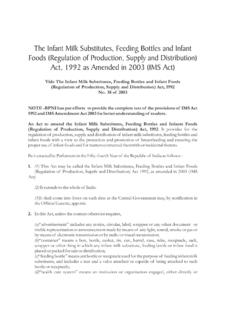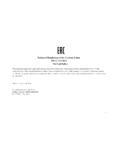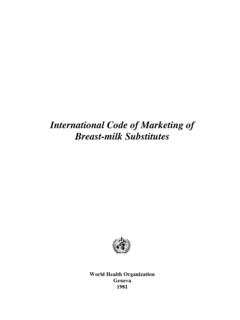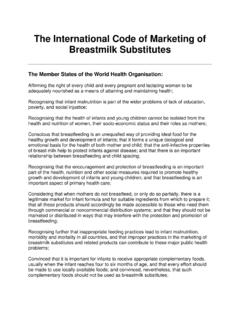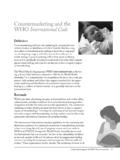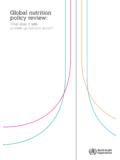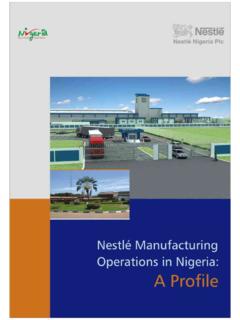Transcription of GUIDELINES FOR USE OF BREAST-MILK SUBSTITUTES IN …
1 GUIDELINES FOR USE OF BREAST-MILK SUBSTITUTES IN emergency SITUATIONS General Statement These GUIDELINES are intended for use by qualified staff and not for wide distribution. It is suggested to provide the flyers to mothers/caregivers that willbeusingthesubstituteRecommendations for the use of BREAST-MILK SUBSTITUTES Mothers/caregivers should be taught about safe preparation of the BREAST-MILK substitute Possible BREAST-MILK SUBSTITUTES include: commercial infant formula, liquid animal milk (cow or goat), powdered animal milk , evaporated milk All other milks are unsuitable for small infants The instructions for mixing the commercial formula need to be followed exactly according to the supplier recommendations The recommendations when using liquid cow or goat milk in infants less than 6 months old and for each feed are the following.
2 O For the one-month old mix 40 ml of milk with 20 ml of boiled water and add 4 g of sugar o For a two-months old mix 60 ml of milk with 30 ml of boiled water and add 6 g of sugar o For infants 3-4 months old mix 80 ml of milk with 40 ml of boiled water and add 8 g of sugar o For infants 5-6 months old mix 100 ml of milk with 50 ml of boiled water and add 10 g of sugar If the substitute is going to be prepared using powdered full-cream cow's milk the following is recommended for each feed: o For the one-month old infant mix 5 g of milk with 60 ml of boiled water and add 4 g of sugar o For the two month-old mix g of milk with 90 ml of boiled water and add 6 g of sugar o For infants 3-4 months old mix 10 g of milk with 120 ml of boiled water and add 8 g of sugar o For infants 5-6 months old mix g of milk with 150 ml of boiled water and add 10 g of sugar The following is recommended for preparing a substitute using evaporated milk and for each feed.
3 O For the one-month old mix 16 ml of milk with 44 ml of boiled water and add 4 g of sugar o For the two-month old mix 24 ml of milk with 66 ml of boiled water and add 6 g of sugar o For infants 3-4 months old mix 32 ml of milk with 88 ml of boiled water and add 8 g of sugar o For infants 5-6 months old mix 40 ml of water with 110 ml of bolied water and add 10 g of sugar For all BREAST-MILK SUBSTITUTES it is recommended to follow basic hygienic measures for preventing infections: o Wash hands with soap and clean water o Clean all utensils, containers and cups with soap and clean water Mothers/caregivers should give the infant a micronutrient supplement every day The BREAST-MILK substitute should be fed by cup Illustrated demonstrations to prepare the different BREAST-MILK SUBSTITUTES are attachedFor further information, contact: Randa Jarudi Saadeh Scientist World Health Organization Nutrition for Health and Development Tel: +41 22 791 3315/3878 Fax: + 41 22 791 4156 E-mail.
4 Zita Weise Prinzo Technical Officer World Health organization Nutrition for Health and Development Tel: +41 22 791 4440 Fax: +41 22 791 4156 E-mail: Chantal Gegout Nutritionist Nutrition for Health and Development Tel: +41 22 791 4233 Kunal Bagchi Regional Adviser, Nutrition Eastern Mediterranean Region Tel: 202 670 25 35 Fax: 202 670 24 92/94 E-mail: INFANT FEEDINGCOUNSELLING FLYERS World Health Organization, 2005 HOW TO PREPARE COMMERCIALFORMULA Wash your hands before preparing the formula. Make ____ ml for each feed. Feed the baby ____ timesevery 24 hours. Always use the marked cup or glass to measure waterand the scoop to measure the formula powder.
5 Yourbaby needs _____ scoops. Measure the exact amount of powder that you will needfor one feed. Boil enough water vigorously for 1 or 2 seconds. Add the hot water to the powdered formula. The watershould be added while it is still hot and not after it hascooled down. Stir well. Only make enough formula for one feed at a time. Donot keep milk in a thermos flask because it will becomecontaminated quickly. Feed the baby using a cup. Discard any unusedformula, give it to an older child or drink it yourself. Wash the utensils. Come back to see me on FEEDINGCOUNSELLING FLYERS World Health Organization, 2005 HOW TO PREPARE FRESH milk Wash your hands before preparing the formula.
6 Always use the marked cup or glass to measure waterand milk . Fill the cup or glass to the "water" mark with the the water into the pot. Fill the cup or glass to the" milk " mark with the milk . Add the milk to the water inthe pot. Measure the sugar by filling the spoon until it is level/rounded/heaped (circle one). Add_____ spoonfuls tothe liquid. Stir well. Bring the liquid to a boil and then let it cool. Keep itcovered while it cools. Feed the baby using a cup. Discard any unusedformula, give it to an older child or drink it yourself. Wash the utensils. Give your baby a micronutrient supplement every can get it from _____ or can buy will cost _____.
7 Come back to see me FEEDINGCOUNSELLING FLYERS World Health Organization, 2005 HOW TO PREPARE POWDEREDFULL-CREAM milk Wash your hands before preparing the formula. Always use the marked cup or glass to measure waterand a spoon to measure the powdered milk . Boil enough water vigorously for 1-2 seconds and thenlet it cool. Keep it covered while it cools. Measure the powdered milk by filling the spoon until itis level/rounded/heaped (circle one). Put _____spoonfuls in the marked cup or class. Measure the sugar by filling the spoon until it is level/rounded/heaped (circle one). Put _____ spoonfuls inthe marked cup or class.
8 Add a small amount of the boiled water and stir. Fill thecup or glass to the mark with the water. Feed the baby using a cup. Discard any unusedformula, give it to an older child or drink it yourself. Wash the utensils. Give your baby a micronutrient supplement every can get it from _____ or can buy will cost _____. Come back to see me FEEDINGCOUNSELLING FLYERS World Health Organization, 2005 HOW TO PREPARE EVAPORATED milk Wash you hands before preparing the feed. Make _____ml for each feed. Feed the baby _____times each day (24 hours). Always use the marked cup or glass to measure themilk and water.
9 Fill the cup or glass to the " milk " mark with the the milk into the pot. Fill the cup or glass to the"water" mark with the water. Add the water to the milkin the pot. Measure the sugar by filling the spoon until it is level/rounded/heaped (circle one). Put in _____ spoonfuls. Add the sugar to the liquid. Stir well. Bring the liquid to a boil and then let it cool. Keep itcovered while it cools. Feed the baby using a cup. Discard any unusedformula, give it to an older child or drink it yourself. Wash the utensils. Give your baby a micronutrient supplement every can get it from _____ or can buy will cost _____.
10 Come back to see me on FEEDINGCOUNSELLING FLYERS World Health Organization, 2005 CUP FEEDING Wash your hands. Clean the cup with soap and water. Make sure that the baby is awake and held sittingupright. Put a cloth underneath his/her chin to catchany dribble. Hold the cup to the baby's lips and tilt it just enough sothat the milk touches the lips. The cup rests lightly onthe baby's lower lip, and the edges of the cup touch theouter part of the baby's upper lip. Keep the cup tilted so that he/she can sip the milk . Donot pour the milk or push on the baby's lower lip. Your baby has had enough when he/she closes his/hermouth and does not take any more.










